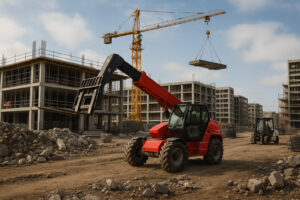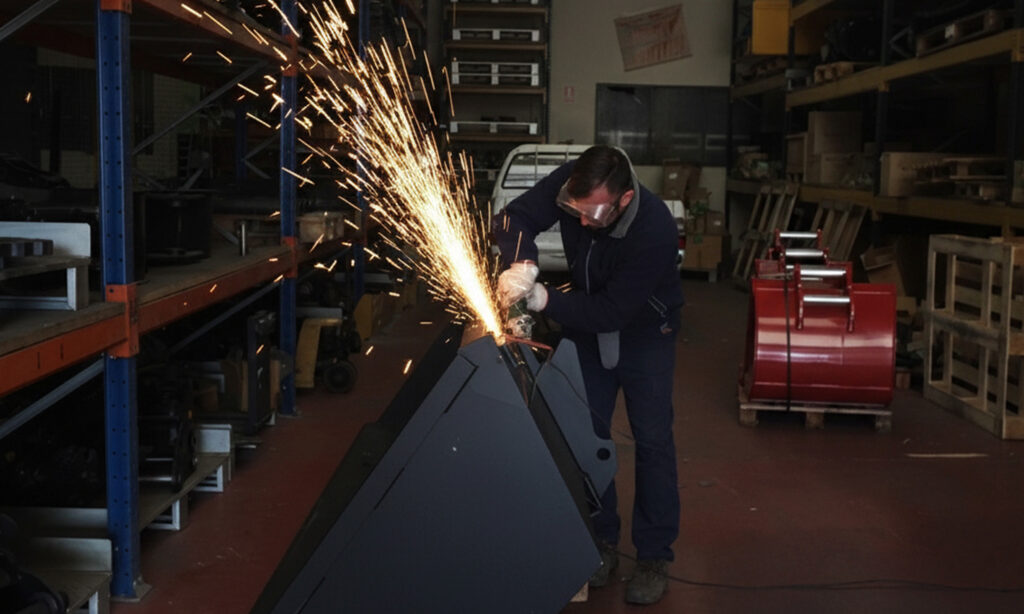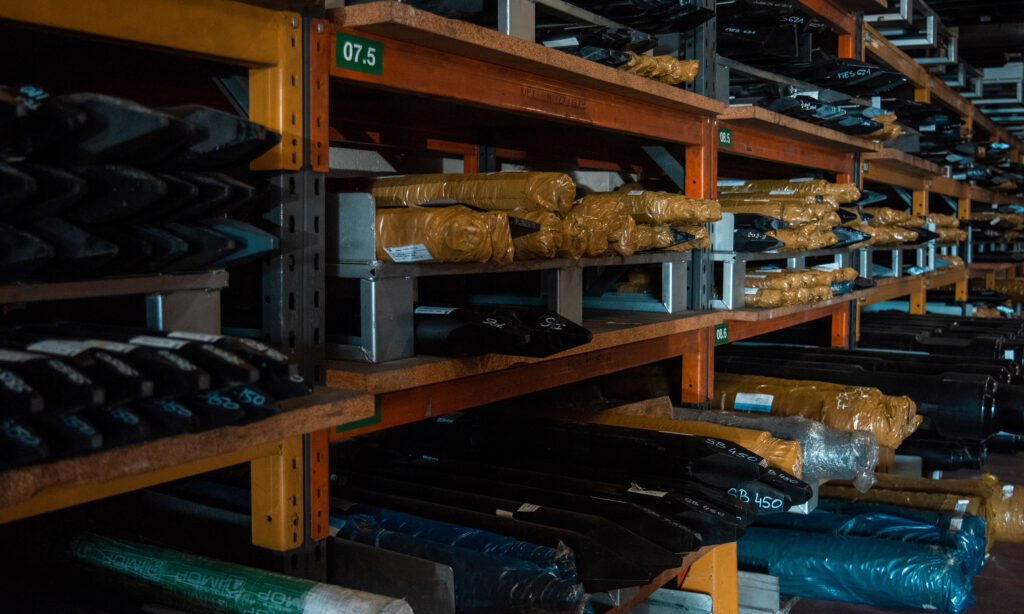The telescopic handler has become one of the most versatile and sought-after machines in both public and private construction projects. It is a multi-purpose machine that combines the best features of a forklift, a crane, and a platform in a single piece of equipment. Its ability to efficiently perform loading, lifting, and material handling tasks makes it a key tool in a variety of industries.
This blog explains what a telescopic handler is, how it works, the different types available, the industries where it is used, and why it is a more efficient option than other solutions on the market.
What is a telescopic handler?
A telescopic handler, also known as a telehandler, is a self-propelled machine with an extendable arm that can move in different directions and heights. This arm allows different attachments (shovels, forks, baskets, etc.) to be attached, making the telescopic handler a highly versatile tool.
Thanks to their design, they can access hard-to-reach places, move heavy materials at great heights, and adapt to multiple jobs in different sectors. Telescopic handlers are among the most sought-after handling equipment in sectors that require strength, reach, and adaptability.
How does a telescopic handler work?
The operation of a telescopic handler is based on a hydraulic telescopic arm that extends and retracts to reach different lengths. This arm, combined with a mobile base with drive wheels, allows it to move over uneven terrain and adapt to the most demanding environments.
This tool is equipped with an extendable arm capable of reaching heights of over 20 meters on certain models. Its robust chassis makes it ideal for demanding jobs. The cab, designed with intuitive controls, provides the operator with optimal visibility, greater safety, and precise control in every maneuver. Its safe and efficient design ensures optimal performance in all types of applications, even in complex conditions.
In addition, its interchangeable attachments allow the equipment to be transformed into a wheelbarrow, loader, crane, or lifting platform, easily adapting to multiple tasks. Thanks to the wide variety of attachments available, a single piece of equipment can perform very different tasks in construction, agriculture, or industry.
Types of telescopic handlers
Telescopic handlers are classified into different types according to their design, size, and functionality. This variety allows the machine to adapt to different sectors, types of terrain, and construction projects.
1. Fixed telescopic manipulator
The fixed telescopic handler is characterized by having an arm that only moves in a linear direction, without the possibility of lateral rotation. Although it lacks rotation on its axis, it has excellent stability and high load capacity.
It is highly efficient for repetitive tasks such as lifting heavy materials, transporting, or installing at height. This construction machinery is ideal for projects where constant rotation is not required, and a cost-effective and robust solution is valued.
2. Rotary telescopic manipulator
Also known as a rotating telescopic handler, it incorporates a turret that can rotate 360 degrees, allowing circular movements without moving the base. It is very useful on construction sites with limited space or structural obstacles. Thanks to its versatility, it can operate from a single position, making it perfect for urban tasks, façade renovations, and roof installation.
3. Compact telescopic handler
Designed to move with agility in confined spaces, such as warehouses, industrial buildings, or greenhouses. Despite its size, it maintains good lifting capacity and reach. Its maneuverability in limited spaces and low impact on the ground make it an excellent choice for industrial, agricultural, or heavy-duty environments.
Differences between telescopic handlers, forklifts, and cranes
It is essential to understand the differences between a telescopic handler, a forklift truck, and a crane in order to choose the most suitable type of machinery.
The telescopic handler offers great vertical and horizontal reach, has a high load capacity, great maneuverability on uneven terrain, and remarkable versatility thanks to the attachments it supports.
On the other hand, the forklift truck is perfect for loading and unloading materials on flat surfaces and in logistics. However, it has limited reach and less adaptability.
Cranes, on the other hand, have a much greater reach and can move large structures, but their use is more restricted to specific functions, with little maneuverability and the need for specialized assembly.
This comparison between a crane and a telehandler shows that the telehandler is a more flexible solution, ideal as versatile machinery for public works and sectors with changing needs.
What is a telescopic handler used for?
The telescopic handler has a hydraulic arm that performs multiple tasks such as lifting loads to different heights; moving materials on difficult terrain; earthmoving; installing prefabricated or metal structures; and placing fences, posts, or signage.
It is an ideal solution when you need a single piece of equipment capable of handling a wide variety of tasks in a construction or agricultural project.
Main sectors where it is used
This tool has applications in multiple key sectors. In construction, it optimizes work at height, on-site logistics, and the assembly of structures. In agriculture, it can be used as agricultural machinery to move bales, load grain, or clean facilities.
In industry and logistics, it facilitates warehouse organization and the transport of goods. And in mining and renewable energy, its power and precision are ideal for turbine maintenance or tasks in remote areas.
In all these sectors, it stands out as a multifunctional machine for construction and other environments where adaptability is key.

This versatile tool has become indispensable for those seeking to optimize their processes without sacrificing efficiency. It is not just a machine: it is a strategic investment that can transform the way you work. Whether in construction, agriculture, or industry, having a telescopic handler in your fleet means gaining in productivity, safety, and results.
Choosing the right model involves taking into account factors such as the type of terrain, the dimensions of the workspace, the required lifting capacity, the type of attachments needed, and the usual working environment. In this regard, seeking advice when purchasing heavy machinery is essential to avoid overspending (or underspending) on the investment.
At IMOP, we help you make the best decision when purchasing your machinery. We offer advice on machinery from a technical team; recommendations based on the type of work, environment, and load; stock of spare parts and components compatible with multiple models; and solutions for handling machinery for demanding projects.




